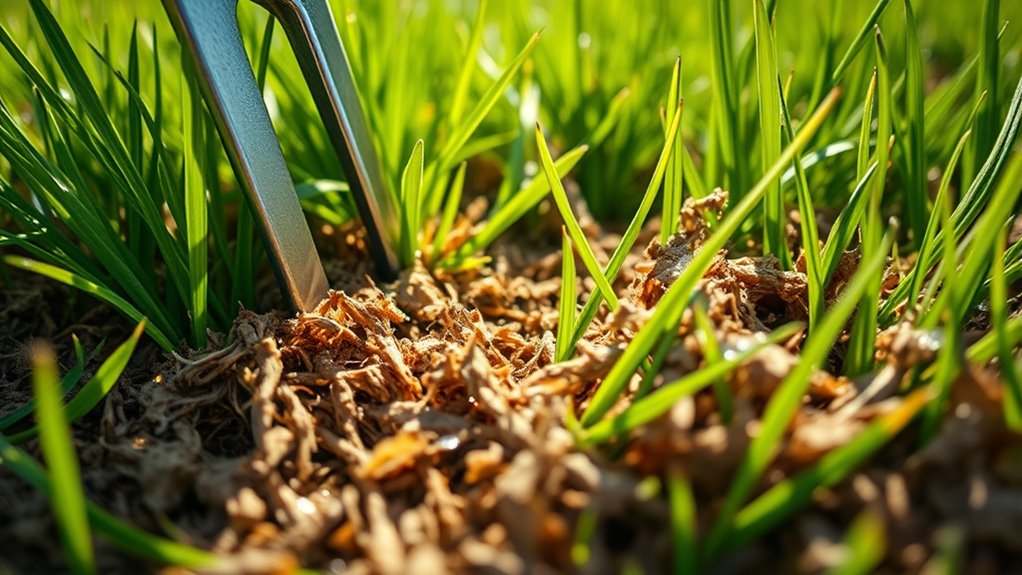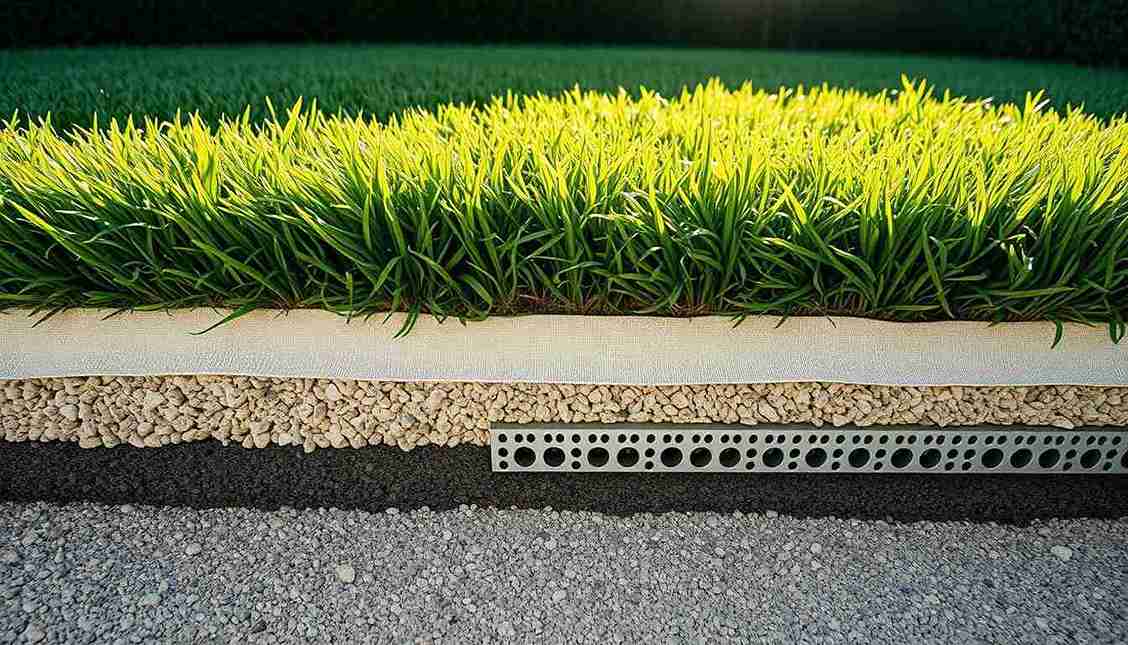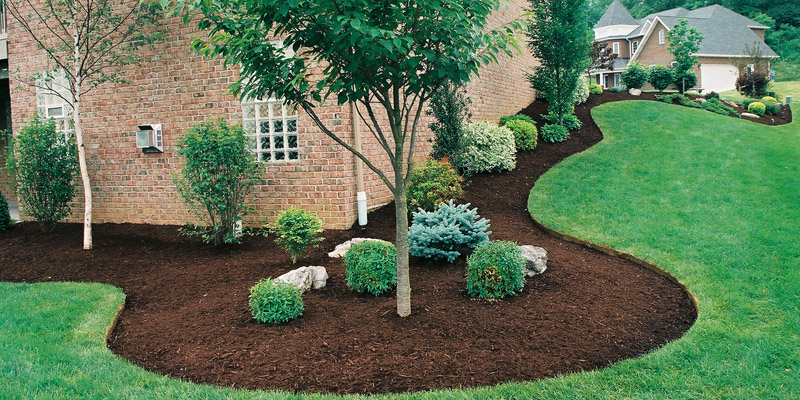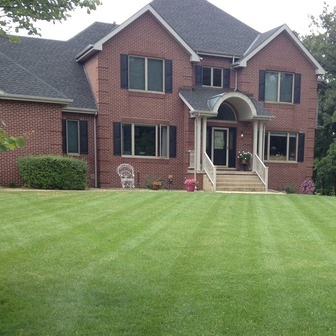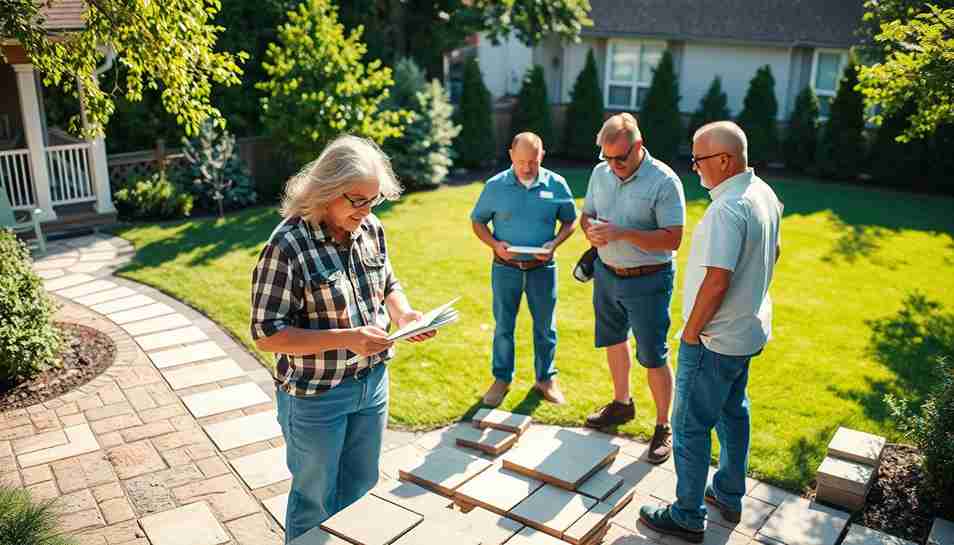Did you know that a single square foot of a healthy lawn can contain hundreds of individual grass plants? Achieving that level of density often requires more than just regular watering and mowing — turf power seeding can help rejuvenate thin areas and promote a thicker, healthier lawn.
Many homeowners face a critical choice when their green space starts to look thin or develop bare patches. The decision between two primary methods can significantly impact your lawn’s future.
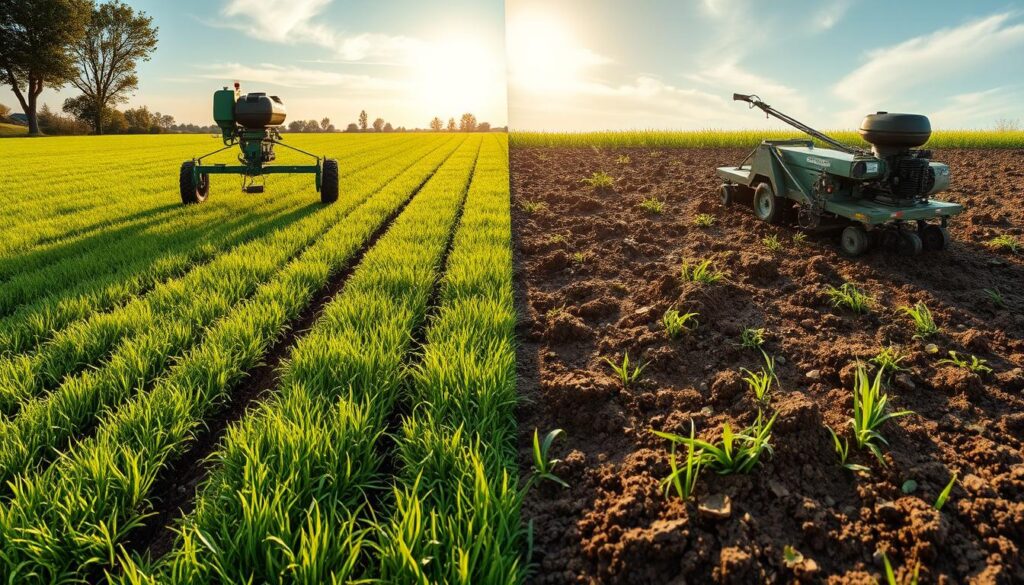
We will break down the fundamental differences between these approaches. Our goal is to provide clear, accessible information to help you make an informed decision for your lawn care investment and choose the best turf seeding topsoil for optimal results.
Both techniques aim to introduce new grass and fill in bare areas. However, turf power seeding and other methods use distinctly different approaches that lead to varying results in terms of grass density and overall lawn health. Selecting the best turf seeding topsoil ensures stronger root development and a more even, lush lawn over time.
Understanding the mechanics behind each process is the first step. This knowledge allows you to choose the best strategy for transforming your outdoor space into a vibrant, thick carpet of green.
Understanding Turf Power Seeding
The same precision planting technology used by golf course managers is now available for residential lawn renovation. This advanced approach ensures consistent results that traditional methods cannot match.
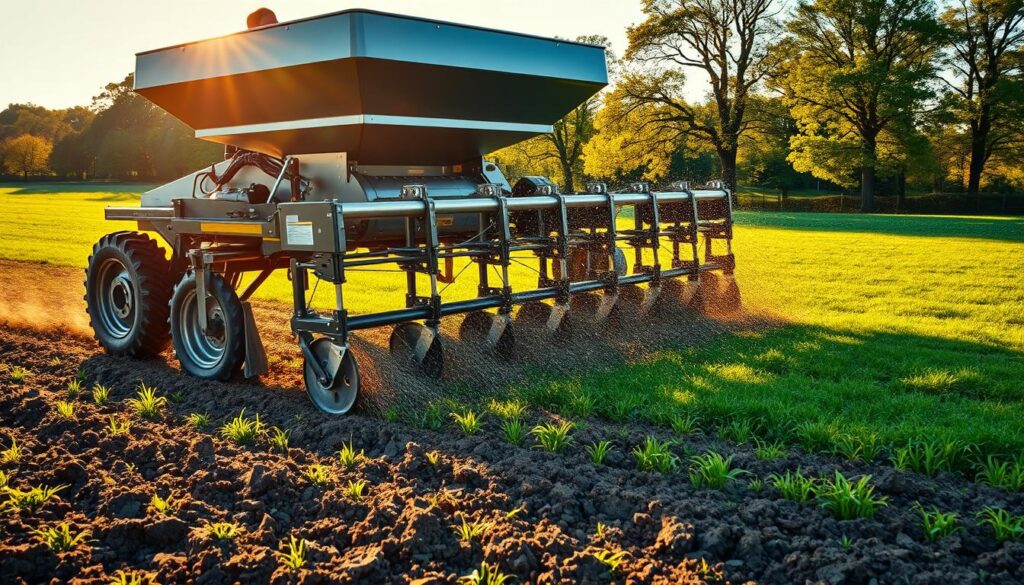
What is Turf Power Seeding?
We use specialized equipment that mechanically cuts precise rows into your soil. This process, often called turf power seeding or slice seeding, deposits grass seed directly into these grooves.
The machine operates like agricultural planting equipment used by farmers. Turf power seeding ensures each seed is placed at the proper depth for successful establishment and promotes stronger, more uniform grass growth.
How It Differs from Traditional Seeding Methods
The fundamental difference lies in guaranteed seed-to-soil contact. Traditional surface spreading leaves seeds vulnerable to weather and poor germination.
With our mechanical approach, you’ll see planted rows confirming proper installation. This eliminates guesswork and gives confidence in your lawn care investment.
We use premium turf-type tall fescue blends during the process. Quality seed combined with proper planting technique produces superior, thick grass coverage.
Mechanics of Aeration and Overseeding
The two-step process of aeration followed by overseeding has been a standard lawn renovation method for decades. This approach aims to address both soil compaction and thin grass coverage simultaneously.
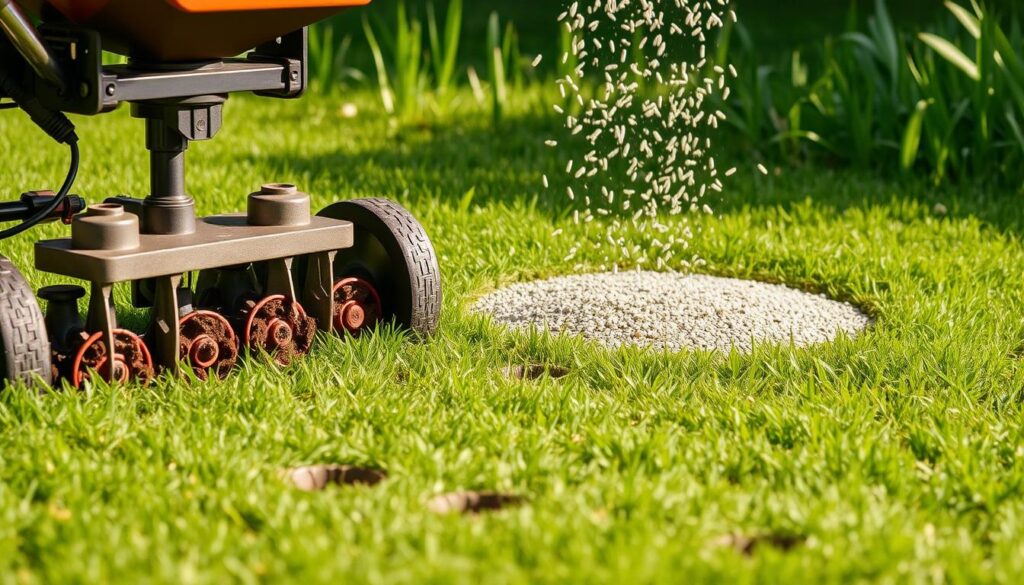
How the Aerator Impacts Soil Contact
We begin with an aerator machine that pulls cylindrical cores from your lawn. This creates numerous holes that improve oxygen flow to root systems.
The openings allow better nutrient absorption and water penetration. However, the spacing between these holes leaves significant surface area untouched.
Challenges with Seed Placement
After aeration, we broadcast grass seeds across the entire lawn surface. The hope is that seeds will naturally fall into the freshly created holes.
This method relies heavily on chance rather than precision. Many seeds remain exposed on the surface where they face multiple threats.
Birds often consume these unprotected seeds before germination can occur. Wind and sun exposure further reduce successful establishment rates.
The inconsistent placement leads to uneven grass growth patterns. Areas between aeration holes receive minimal benefit from the overseeding component.
Turf Power Seeding: Key Advantages Over Aeration and Overseeding
Homeowners seeking guaranteed results often discover that turf power seeding provides superior outcomes compared to conventional lawn restoration techniques. The mechanical approach behind turf power seeding eliminates guesswork and delivers measurable benefits from the start.
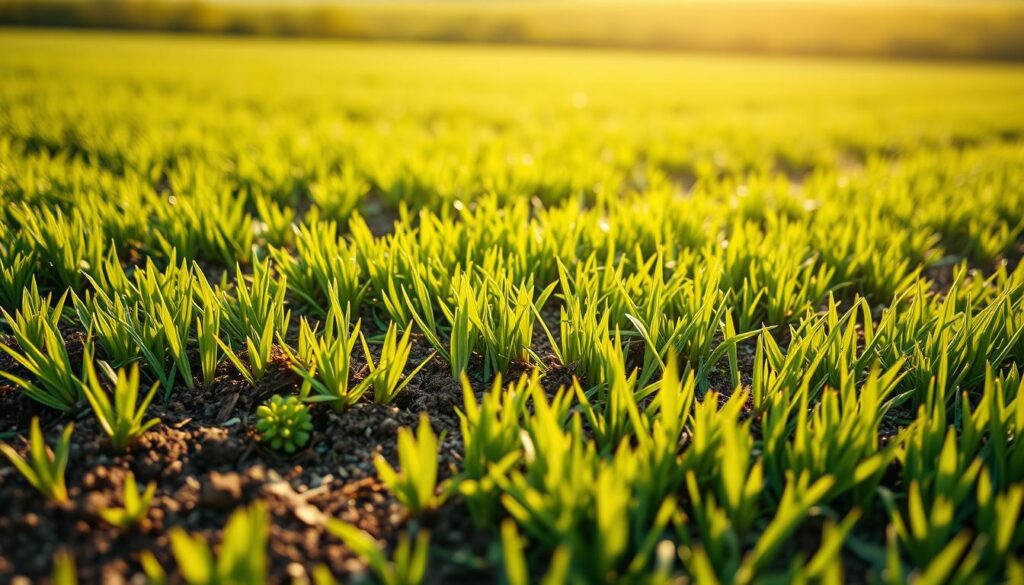
Enhanced Seed-to-Soil Contact
We achieve optimal soil contact by cutting precise grooves into your lawn. Using the best turf seeding topsoil enhances this process, ensuring each seed reaches the ideal depth for successful germination.
Unlike scattered methods, our system protects seeds from environmental threats. When paired with the best turf seeding topsoil, seeds establish stronger root systems more efficiently with consistent moisture and nutrient access.
Visual Results and Faster Grass Growth
Homeowners immediately see planted rows confirming proper installation. This visible proof contrasts with the uncertainty of traditional approaches.
New grass typically emerges within days to weeks. The protected environment accelerates grass growth and delivers thicker coverage faster.
We recommend this method for the most effective use of your lawn care investment. Superior establishment rates mean less wasted seed and more visible transformation.
Optimal Timing and Seasonal Considerations
Timing your lawn renovation project correctly can determine whether you achieve lush, thick grass or face disappointing results. The season you choose affects everything from seed germination to long-term lawn health.
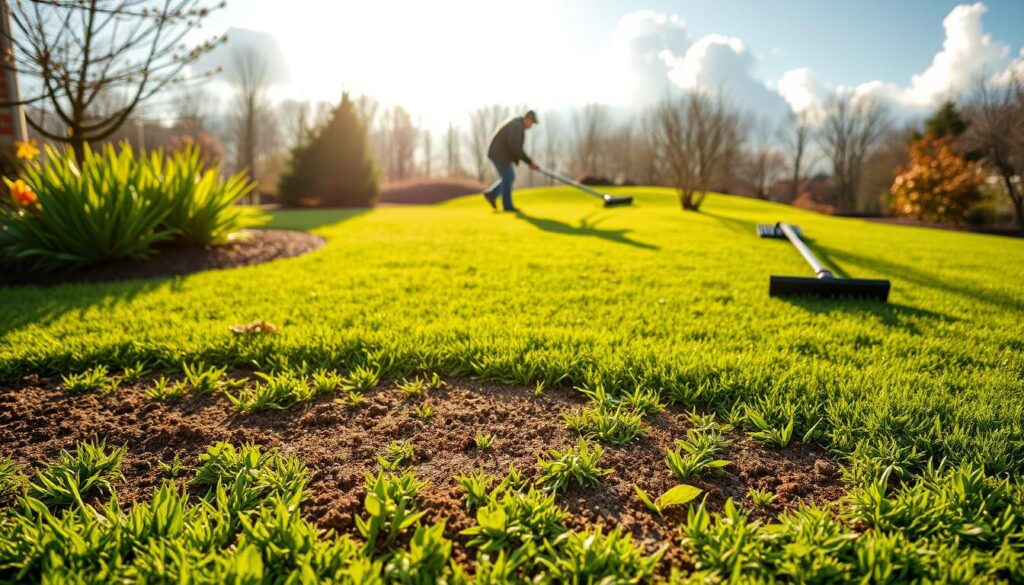
We recommend scheduling this work during specific windows when environmental conditions favor success. Understanding these seasonal patterns helps you make informed decisions about when to begin your project.
Why Fall is Ideal for Power Seeding
Fall emerges as the premier season for introducing new grass to your landscape. The combination of warm soil and cooler air creates perfect growing conditions.
Soil retains summer warmth, which activates seed germination effectively. Meanwhile, moderate air temperatures reduce stress on emerging seedlings.
This seasonal balance allows grass to develop strong root systems before summer heat arrives. The extended favorable period gives your lawn the resilience needed for long-term health.
Impact of Temperature and Soil Conditions
Temperature and soil quality work together to influence seeding outcomes. Fall conditions provide the ideal balance for successful establishment.
Spring planting presents significant challenges despite being a popular time for lawn work. New grass has a limited time to establish before confronting summer stress.
Additionally, spring applications often conflict with weed control products. This forces difficult choices between establishing new grass and preventing weeds.
| Factor | Fall Conditions | Spring Conditions | Impact on New Grass |
| Soil Temperature | Warm from summer | Cool from winter | Faster germination in fall |
| Air Temperature | Cooling trend | Warming trend | Less stress on seedlings in fall |
| Moisture Availability | Seasonal rainfall | Variable precipitation | More consistent moisture in fall |
| Weed Competition | Decreasing | Increasing | Better establishment in fall |
Scheduling during the optimal fall window gives your lawn the best chance for successful establishment. This timing translates to better coverage and a healthier appearance by the following growing season.
Technical Insights: Equipment and Process
Advanced lawn restoration begins with understanding the technical differences between modern equipment and traditional tools. The machinery we use determines how effectively new grass establishes in your landscape.
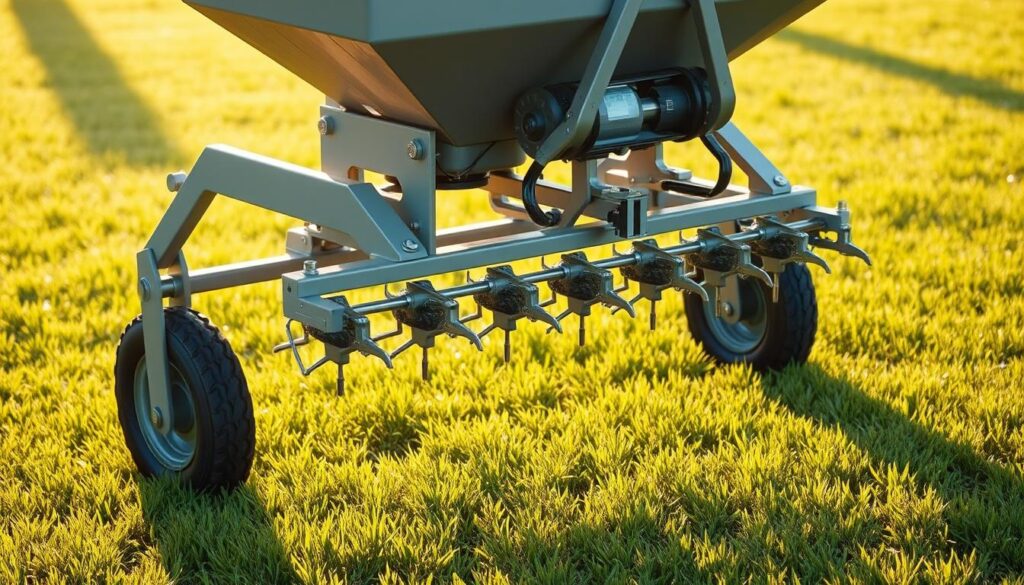
Professional services have moved beyond basic approaches to embrace more sophisticated techniques. These innovations deliver consistently better results for homeowners.
Machinery and Methods: Aerovation vs. Aeration
While standard aeration pulls soil cores to improve oxygen flow, we employ an advanced method called Aerovation. This process uses vibrating tines that fracture the ground more effectively.
The equipment creates a deeper, more thoroughly prepared environment for seeds. When combined with the best seeding topsoil, this superior soil preparation gives grass a stronger foundation for successful establishment and long-term lawn health.
Innovative Techniques in Slice Seeding
Our slice seeding equipment represents a significant technological advancement. The machine creates precise cuts in your lawn while simultaneously depositing seeds.
This mechanical approach ensures consistent depth and spacing for each seed. The result is uniform coverage that eliminates patchy growth patterns.
We invest in professional-grade equipment because the right tools make a measurable difference. Superior machinery translates to healthier, denser grass for your outdoor space.
Making the Right Choice for a Beautiful, Healthy Lawn
Choosing the right lawn renovation method depends on understanding your specific goals for your outdoor space. We help homeowners evaluate their landscape to determine the best approach for long-term success.
Assessing Your Lawn’s Specific Needs
Not every property owner desires a pristine, golf-course quality landscape. Some simply want a decent-looking yard with basic weed control.
For these homeowners, traditional aeration may meet minimum needs. However, those aiming for the best lawn in the neighborhood should consider more advanced techniques.
Extensive bare patches and thin areas indicate a need for comprehensive treatment. These problem spots make lawns look unhealthy and invite weed growth.
Our Recommendations Based on Proven Results
We consistently observe that mechanical slice seeding delivers superior outcomes. This method excels at filling in bare spots and creating a thick, lush carpet of grass.
A thicker lawn naturally chokes out weeds by reducing available space. This minimizes the need for chemical herbicides and creates a more resilient landscape.
We recommend this service every other year for ongoing improvement. This schedule maintains density while managing your overall lawn care budget effectively.
| Lawn Goal | Recommended Approach | Key Benefit |
| Basic maintenance & weed control | Traditional Aeration | Meets fundamental needs |
| Filling noticeable bare patches | Enhanced Overseeding | Addresses specific problem areas |
| Superior thickness & weed resistance | Mechanical Slice Seeding | Creates dense, healthy grass |
After completing any service, we perform quality checks to ensure proper grass establishment. This confirms homeowners see the results they expect from their investment.
Conclusion
Making an informed choice about your property’s green space requires careful consideration of how different techniques impact long-term results. We’ve demonstrated that mechanical planting methods deliver superior outcomes compared to traditional approaches.
The evidence clearly shows that precise seed placement leads to better germination and healthier grass development. This approach ensures each seed reaches optimal soil conditions for successful establishment.
Fall remains the ideal season for lawn renovation projects. The combination of warm soil and moderate temperatures creates perfect conditions for vigorous growth before summer stress arrives.
For homeowners seeking professional-quality results, we recommend investing in advanced techniques. These methods provide the thick, resilient coverage that naturally resists weeds and maintains beauty.
Your landscape deserves the best opportunity to thrive. Understanding these differences empowers you to make choices that enhance your outdoor environment for years to come.
Ready to Revive Your Lawn?
Experience the difference with professional turf power seeding. Our proven process and best seeding topsoil deliver a thicker, greener lawn that lasts. Don’t settle for patchy results — schedule your lawn renovation service with C&T Lawn and Landscape today and see visible improvements fast!
Visit our location or book your free estimate to get started.


